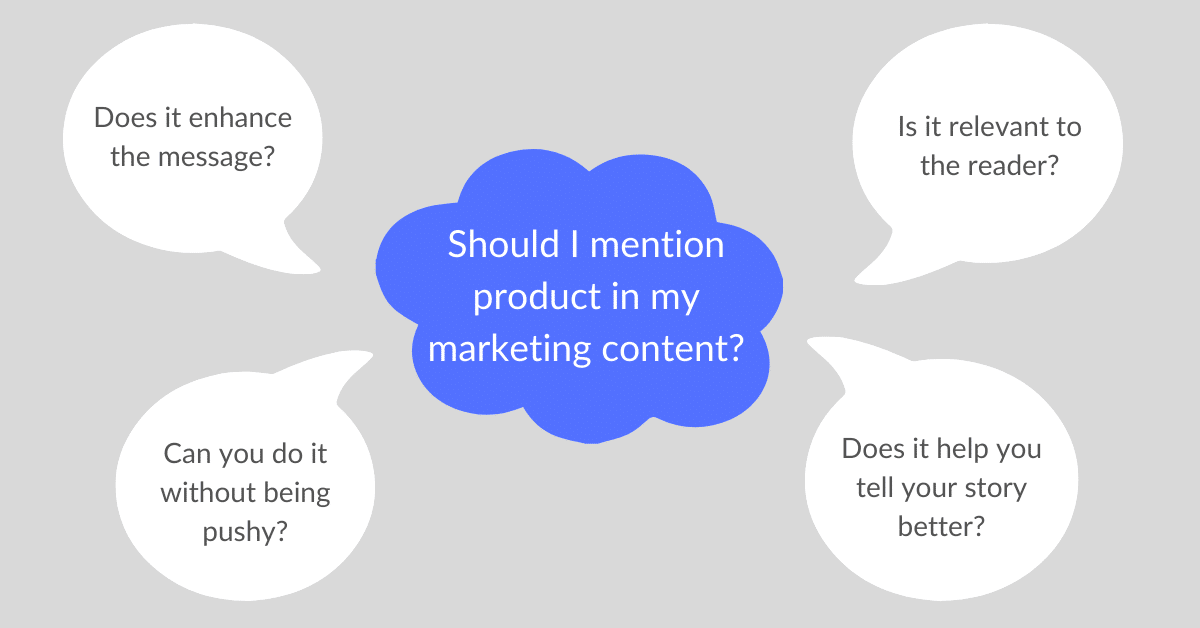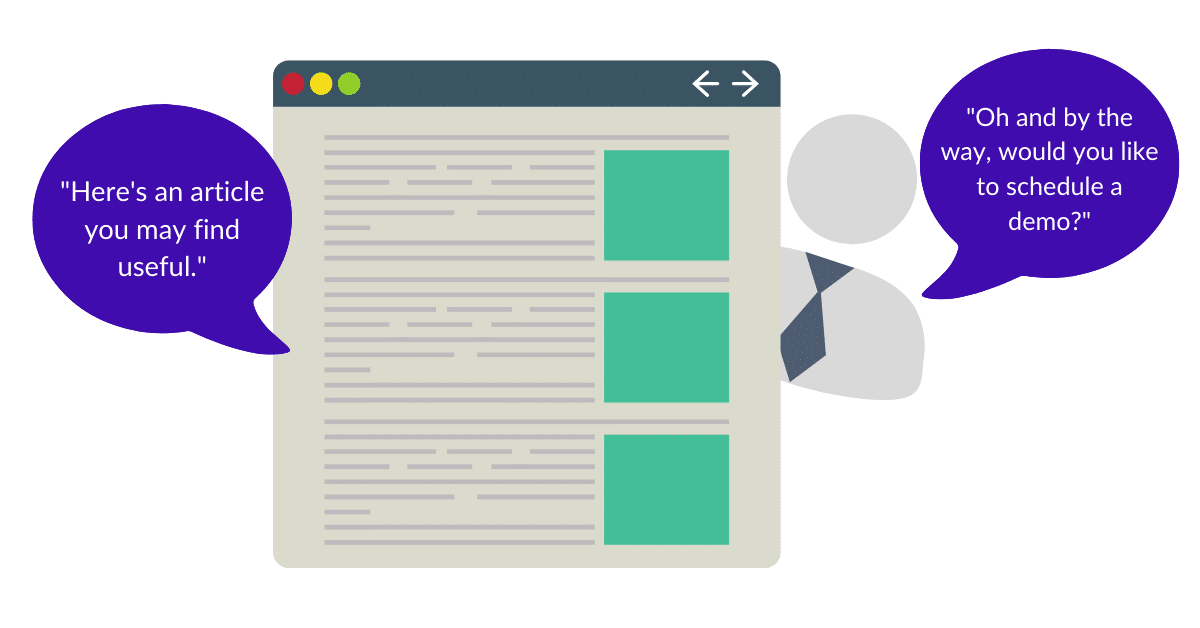Every company wants to mention product in their content. But that doesn’t necessarily mean you should.
Not everything you publish should end with “Want to to learn more about [topic]? Contact us for a demo.” Not everyone who reads your content is ready to hear about your product at that very moment.
For instance, if you’re addressing a top-of-funnel issue, the reader may not even know they have a problem yet. The solution to that problem is certainly going to be far from their minds.
Talking about product at this point could seem self-serving and, worse, could compromise trust with your audience.
On the other hand, if you’re writing a case study, product is a pretty important piece of the story. In that situation, it’s completely appropriate to talk about it.
The key here is context. There’s no blanket rule for when it’s appropriate to mention product in your content. You have to look at the specifics to see whether it makes sense.
Here are four questions to help you figure that out.
1. Does it enhance the message?
Your product and your expertise aren’t two isolated things. They’re intertwined by their very nature.
It’s your expertise that led you to create a product to solve a gap in the market. And it’s your product and how your customers use it that provide you the insights that grow your expertise.
If you didn’t build the product or provide the service, you wouldn’t have a leg to stand on.
Thus, setting a hard and fast rule that you should never mention your product means divorcing your expertise — which provides the substance of what you talk about in your content — from the source.
This is especially true if there’s a situation where talking about your product could support a claim you’re making. In these situations, talking about your product will enhance the message rather than detract from it.
So that’s the first question to ask. Are you enhancing the message by mentioning your product? If so, then it could be a good decision to include it.
However, if you have to shoehorn in a reference to the product, it’s not enhancing the message but detracting from it. In that case, it’s best to not mention product in your content.
2. Is it relevant to the reader?
Just as mentioning your product should enhance the message of your content, it should also be something that your reader actually would be interested in.
Remember the #1 metric of content quality: whether your content is addressing a real-life customer problem. Everything you write about should be focused toward that singular goal of providing specific value based on their interests, not yours.
Consider the three broad categories of content based on the buyer’s journey:
- Awareness-level content helps your buyer realize they have a problem and surfaces the pain points that your product solves.
- Consideration-level content helps your buyer weigh potential solutions and talks about the various competitors (both direct and indirect) that you face.
- Decision-level content helps your buyer make a final decision on whether to go with your product or a competitor’s.
If you’re writing decision-level content, discussions around your product are going to be highly relevant, as that reader is going to be actively considering whether they want to do business with you.
In fact, not mentioning product at this stage could be dangerous, as they may get annoyed that you aren’t providing truly relevant information, and it could hurt your chances of closing a deal.
Mentioning product in your awareness-level content, on the other hand, has a significant chance of backfiring. Not only does it not make sense to that reader, but it could come off as opportunistic or pushy.
Understanding what your reader wants to hear is a part of good writing in general, but it’s also key to finding the balance of whether to mention product in your content or not.
3. Can you mention it without being pushy?
We all know the “sales pitch disguised as a helpful article” ploy.
You click on your news feed to read about the “How to Enhance Your Team’s Workflows” to realize that apparently the only way to do that is to buy the company’s product.
Rather than help you actually figure out how to enhance workflows, the article has just been a 1,200-word sales pitch.
This is not only annoying, but it really doesn’t do your business any favors. People don’t respond to pushy salespeople. Consider the following stats:
- 78% of B2B buyers want a salesperson who listens to and solves their needs, rather than challenges them.
- 88% of buyers prefer salespeople to be “trusted advisors,” according to 2018 data from LinkedIn.
- 87% of consumers prefer to pre-research products online before making a purchase.
None of these stats are surprising. We all do our homework before making a big purchase. Your buyers are no different.
So if you’re being pushy with your product, you’re going against the way that most people want to consume content.
The good news is, there are plenty of ways to engage your readers and drive them to a next step that’s less intimidating than a demo request:
- Subscribe to your blog for more information
- Sign up for regular email updates
- Download a full guide on this topic
- Leave a comment with your thoughts (this one is highly underutilized!)
These are just a few. There are potentially limitless calls-to-action out there.
If you think you’re being pushy, think about this: if the buyer takes the next step, is it because they want to, or because they feel pressured to? If it’s the latter, consider dialing back.
4. Does it help tell your story?
Regardless of the specific products or services you have, you’re in the storytelling business.
This sounds trite, mainly because “storytelling” is an overused word among marketers. Even so, there are a number of specific stories that you’re telling when you communicate with your audience:
- The story of your buyer as they proceed along the buyer’s journey
- The story of your company as you innovated to solve a problem in the market
- The stories of current customers as they used your products or services to solve key problems they’ve faced
And all stories, regardless of the specifics, follow the same basic structure: setup, conflict, and resolution.
How does your product fit into a particular story? Is your buyer interested in hearing about potential solutions to their problem, thus moving them from conflict to resolution in the story? If so, then your product is a key component of that story.
If it fits naturally into the story you’re telling, then it’s absolutely appropriate to mention product in your content.
This could enhance your readers’ interest and, in turn, make them more likely to engage. Which could lead to a successful purchase down the line.








